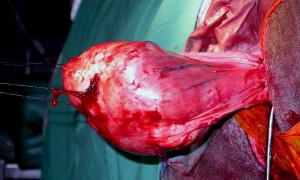Ovariectomy (the surgical removal of ovaries) in horses can be performed using a variety of approaches, including laparoscopic techniques, which allow the mare to be operated on while standing. However, laparoscopy can be expensive and expertise is required to operate the equipment necessary for a successful and safe operation. In a short communication recently published in Veterinary Record, Gal Kelmer and coworkers report an open flank approach to remove enlarged pathological ovaries that doesn’t require general anaesthesia and avoids the drawbacks of laparoscopy.
Fourteen mares had a unilateral ovariectomy using a standing open flank approach for removal of an enlarged ovary. After sedation, the abdominal cavity of the horses was accessed through a long vertical incision. The external abdominal oblique, internal abdominal oblique and transversus muscles were incised. The surgeon’s hand was then inserted into the abdomal cavity, the enlarged ovary was located and gently pulled toward the incision. Once the ovary was in view and could be reached, heavy traction sutures were placed in the ovarian tissue. The ovary was gradually brought outside of the abdomen and the ovarian pedicle tied off using simple overlapping sutures and a stapling device. During the closing of the abdomen, a suction drain was placed between the external and internal abdominal oblique muscles and the incision closed in layers.
All ovaries were successfully removed without major complications. Three mares developed an incision infection but these healed unremarkably after treatment. Histological evaluation was carried out in 10 cases, revealing granulosa theca cell tumours in nine ovaries and a cystic ovary in one. All mares (with the exception of one that had both ovaries removed) returned to their normal oestrus cycle within three to 12 months after surgery and 12 mares foaled within 30 months of surgery.
The authors conclude that ovariectomy performed with the mare standing using an open flank approach is a safe and efficient technique for removing enlarged pathological ovaries, which avoids the complications associated with general anaesthesia. They add that, overall, there was a low incidence of complications using this method of ovariectomy, cosmetic results and owner satisfaction were good and the mare’s reproductive performance following surgery was excellent.
Gal Kelmer, the lead author states:
“Ovariectomy always fascinated me as a surgical procedure. In my residency in Missouri we started using standing laparoscopy for removing ovaries and the procedure was exciting to learn and perform since we used all kinds of new surgical toys. Once I returned to Israel we faced a surge of ovarian tumors in Arabian mares and laparoscopic equipment was not available. I was reluctant to retreat to the old-fashioned way of removing them under general anaesthesia through the ventral abdomen. That old-fashioned way was fraught with complications. Complications were related both to the anaesthesia and recovery and directly to the approach since the ovaries are difficult to access through the ventral body wall due to their attachment to the opposite body wall. Thus, we decided to avoid general anaesthesia and use a flank approach with the mare standing and sedated. Up until recently, it was considered as an axiom that large ovaries, over 10 cm, cannot be safely removed through the flank and a ventral approach under general anaesthesia is mandatory in these cases. We, however, safely remove enlarged, diseased, ovaries up to 30 cm in diameter, via an open flank approach in 14 standing mares. Mares returned to reproduction activity and foaled and owners were satisfied with the results. The use of staples in the procedure is not essential; one can secure the mesovarium with another line of sutures for safe ligation. One should remember that a standing surgery does not necessarily directly translates as ‘easy’ and ‘minor’. One should take ovariectomy seriously since complications can be fatal. Overall, we believe the procedure is uncomplicated and effective and offers a good alternative for experienced surgeons who do not have laparoscopic equipment available.”
